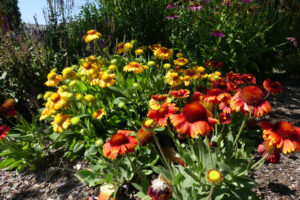What’s a Seed Library?
A seed library is a collection of seeds shared with anyone in the community. “Borrowed” seed gets planted in community gardens and “returned” seed replenishes the collection for future borrowers, creating a sustainable seed system!
The Sandpoint Seed Library is located on the first floor near the elevator.

How to use the Sandpoint Seed Library:
Borrowing Seeds
The Sandpoint Seed Library operates on an honor system. We trust that our members properly “check out” only what they need to grow. We ask that you respect that the seed library is a shared public resource and to take only what you will use during the season.
- Fill out a membership form to register as a Sandpoint Seed Library member.
- Choose your seeds. You probably don’t need a lot! One tomato plant grown from one seed can produce up to 30 pounds of tomatoes!
- Grow your plants. We encourage you to save seeds to return to the Seed Library, of course.
Get help from books
Find books at The Library to help you on your gardening journey.
Seed Saving
When saving seeds choose open-pollinated varieties, rather than hybrids. Open-pollinated varieties may be “heirloom” varieties that have been passed down from one generation of gardeners to the next, or they may be more recent selections.
If you’re just starting out, here are a few of the easiest plants to save seed from:
- Tomatoes
- Beans
- Peas
- Lettuce
- Dill
- Peppers
Storage – Store properly dried seeds in a moisture-proof container. Small plastic bags, paper envelopes, or glass jars are all excellent choices. If using plastic bags, make sure to squeeze out all of the air. Keep seeds dry, dark and cool. Avoid light and never store seeds in direct sunlight or a well-lit room. When you are ready to use your seeds, keep them in their closed storage container until the seeds come to room temperature. This will prevent unwanted condensation from settling on the seed packets.
Returning Seeds
It is important that members make an effort to return seeds to keep the collection sustainable but there is no requirement for how many seeds of each variety must be returned.
- After harvesting your seeds, be sure to remove as much chaff as possible, dry them thoroughly and store them in a cool, dry and dark place before you bring them to the library.
- Return your seeds in sealed envelopes or containers and fill out as much information you can on the donation form.
Note: Please donate saved seeds you know are non-hybrid and open-pollinated varieties. Patented seeds or varieties protected by the Plant Variety Protection Act will not be accepted or distributed without permission from the certificate holder.








